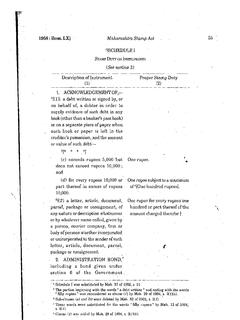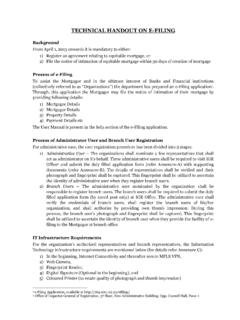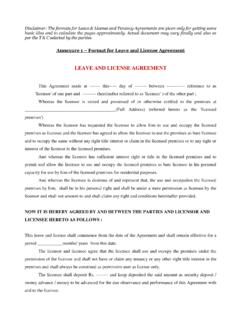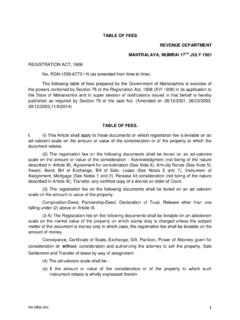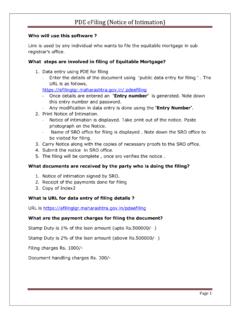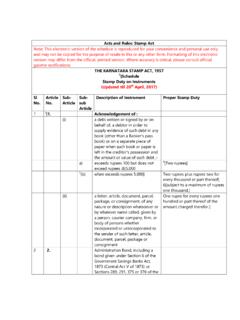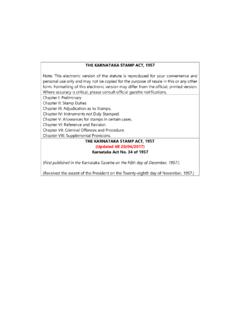Transcription of THE BOMBAY STAMP ACT - igrmaharashtra.gov.in
1 THE BOMBAY STAMP ACT, 1958 [ BOMBAY ACT No. ,LX OF 1958]1 This Act received the assent of the President on 4th June 1958, and assent was first published in the BOMBAY Government Gazette, Part IV, on the 11th June, 1958 An Act to consolidate and amend the law relating to stamps and STAMP duties in the State of BOMBAY Amended by Bom. 95 of 1958. Adapted and modified by the Maharashtra Adaptation of Laws (State and Concurrent Subjects) order, 1960. Amended by Mah. 10 of 1960 Amended by Mah. 17 of 1993 (1-5-1993)4 31 of 1962 20 of 1994 (28-2-1994)4 10of 1965 29 of 1994 (1-5-1994)4 29 of 1972 38 of 1994 (17-8-1994)4 13 of 1974 (1-5-1974)4 12 of 1995 (8-6-1995)4 16 of 1979 (4-7-1980)4 16 of 1995 (1-9-1995)4 27 of 1985 (10-12-1985)4 9 of 19975 (15-9-1996)4 9 of 1988 (22-4-1988)4 30 of 1997 (15-5-1997)4 1 of 1989 (6-1-1989)4 21 of 19986 (1-5-1998)4 18 of 1989 (1-12-1989)4 As Amended by Mah.
2 Tax Law (Levy & 9 of 19903 (7-2-1990)4 Ammedment), Act, 2001 WHEREAS it is a expedient to consolidate and amend the law relating to STAMP and rates of STAMP duties other than those in respect of document specified in entry 91 of List I in the Seventh Schedule to the Constitute of India in the State of BOMBAY ; It is hereby enacted in the Ninth Year of Republic of India as follows :- _____ 1. For Statement of Objects and Reasons, see BOMBAY Government Gazette, 1958 Extra., Part V. P. 122. 2. Maharashtra Ordiance No. VI of 1988 was repealed by Mah. 27 of 1990, (1) 3. Maharashtra Ordiance No. II of 1990 was repealed by Mah. 9 of 1990, (1) 4. This indicates the date of enforcement of Act. 5. Mah. Ordiance No. XII of 1996 was repealed by Mah. 9 of 1997, 6. Maharashtra Ordiance No. VI of 1998 was repealed by Mah.
3 21 of 1998, Constitutional Position Law relate to stamps and STAMP duties regarding documents other than those specified in Entry 91 of List I of Schedule VII of the Constitution, Specified documents are bills of exchange promissory notes, bills of lading, letters of credit, policies of insurance, transfer of shares, debentures, proxies and receipts and the field related to rates of STAMP duties. List II empowers state to enact laws for rates of STAMP duty in respect of documents other than specified in List I. Rates for STAMP duties for specified documents in List I. Entry 91 can by prescribed by Parliament and rates for STAMP duties for other documents can be prescribed by State laws. Entry 44 List II empowers concurrently Parliament and State legislatures to make laws for STAMP duties.
4 Thus levy and charge of STAMP duties can be imposed by both the Parliament and State legislatures subject to repugnancy and occupied field. Rates however have to be prescribed exclusively by Parliament for specified documents and by State legislatures in respect of other documents. Thus the preamble indicates that the Act prescribes rates of STAMP duty and levies STAMP duties on documents as set out in the Act. Section 74 of the Act specifically excludes the documents as mentioned. Scheme of the Act- Section 3 is a charging section and provides for charging STAMP duties on instrument and to that extend it levies duties on instrument and not on the transaction. The taxing events is when the instrument is executed in the State for the first time without being previously executed.
5 Document as defined in Evidence Act means any matter expressed or described upon substance by means of letters, figures or marks or by more than one of those means intended to be used or which may be used for the purpose of recording that matter. Explanations to Section 62 of the Evidence makes each counterpart of a document to be primary evidence as mentioned and where document is executed in several parts each part is primary evidence of the document. Section 4 of the BOMBAY STAMP Act provides for specified documents executed in several parts and the duties chargeable thereon. Here the distinction made is between principal instrument and other instruments Sub Section 4,5,6. Further duty is payable and has to be paid on the principal instrument and it is only when such duties are paid that other instruments can be received in the state having regard to Section7.
6 Section 8 provides for special rates on certain documents as mentioned. Sub-section 10 prescribes the mode of paying duties on instruments by user of stamps on such instruments . Sub-section 10 to 14 are machinery sections providing as to how the STAMP duty is to be collected. Section 15 provides that when STAMP duties are not paid as provided for then the instrument shall be deemed to be not duly stamped. Sub-section 17 to 19 prescribes the time when STAMP duty can be said to be duly paid. Events prescribed are two-(1) When the instrument is executed in the state; (2) When the instrument though executed outside is brought into the State. Sub-section 20 to 29 sets out as to how the instruments have be valued for the purposed of STAMP duty. Sub-section 21 to 23, 25 prescribes how ad valorem STAMP duties have to be valued.
7 Sub-section 24,26, 17 provides for the valuation is cases as mentioned therein. Section 28 prescribes that all matters must be mentioned in the instrument affection chargeability to STAMP duty. Section 29 provides for apportionment of duties regarding separate parts of instrument among different persons. Section 30 provides for persons liable to pay the STAMP duties. Chapter III SCHEDULE 31 TO 32 C provides for adjudication. Chapter IV deals with consequences and effect of instruments correctly stamped and not correctly stamped. In particular it contains provisions for impounding of instruments and for inadmissibility of instruments not duly stamped in evidence. Penalty proceedings and prosecutions are provided for. Refund of penalty and excess duty are provided for in Section 44 whilst Section 46 provides for recovery of duties and penalties by distress and sale of movables or as arrears of land revenue as provided therein.
8 Chapter V makes provisions for allowances and the procedure for the same. Section 52 B provides that stamps purchased have to be used within 6 months and if not so done or no allowances is claimed the same shall become invalid. Chapter VI provides for reference, revision and appeal against orders passed under the Act. Procedure for offences and for penalties are provided in Chapter VII. Chapter VIII contains supplemental provisions and inter alia in Section 69 confers rule making power on State Government generally for purposes of the Act and for specifically provided subject. Rounding off of fractions (Section 70) and delegation of power is provided for (Section 72). Court fees are excluded as subject matter of the Act under Section 73. Schedule I mentions description of instrument and provides for the proper STAMP duty as chargeable.
9 Perusing the above, it may be observed that STAMP duty becomes and important source of revenue for the State affection various transaction of individuals though it is duty levied on instruments meaning documents which create rights or liability or transfers, limits, extends, extinguishes of records such rights or liabilities. Further generally speaking it is an indirect source of revenue though duty becomes payable by the parties to the documents que the State. Noting the legislative history it may be noted that Acts 27 of 1985, 17 of 1993, 20 of 1994, ordinance 12 of 1996 did bring about changes of material nature in the Act as it stood enacted. Further note the provisions relating to amnesty being given in respect of instruments executed on the after to in the State of Maharashtra under Amnesty Scheme applicable as between to in relation to residential premises in cooperative housing society or under Ownership Flats Act to the extent of rates as applicable under Article 25(d) to Schedule I.
10 For getting amnesty what is required is (a) to make an application with instrument in original with Xerox copies as required and with STAMP affixed of 65 paise; (b) along with affidavit as prescribed in form as given. All details regarding location of property, ward number, number of storeys, year of construction. Area of flat required to be stated in the application made to the Collector of Stamps. Market value then will be ascertained. This concept of market value was brought in Amnesty Act, 1979. Occupying house or premises of flat as owner or member of a cooperative society or of a condominium or land deals and building construction activity bring in their wake several documents affecting rights and liabilities of individuals as well as legal personalities they are involved with.
